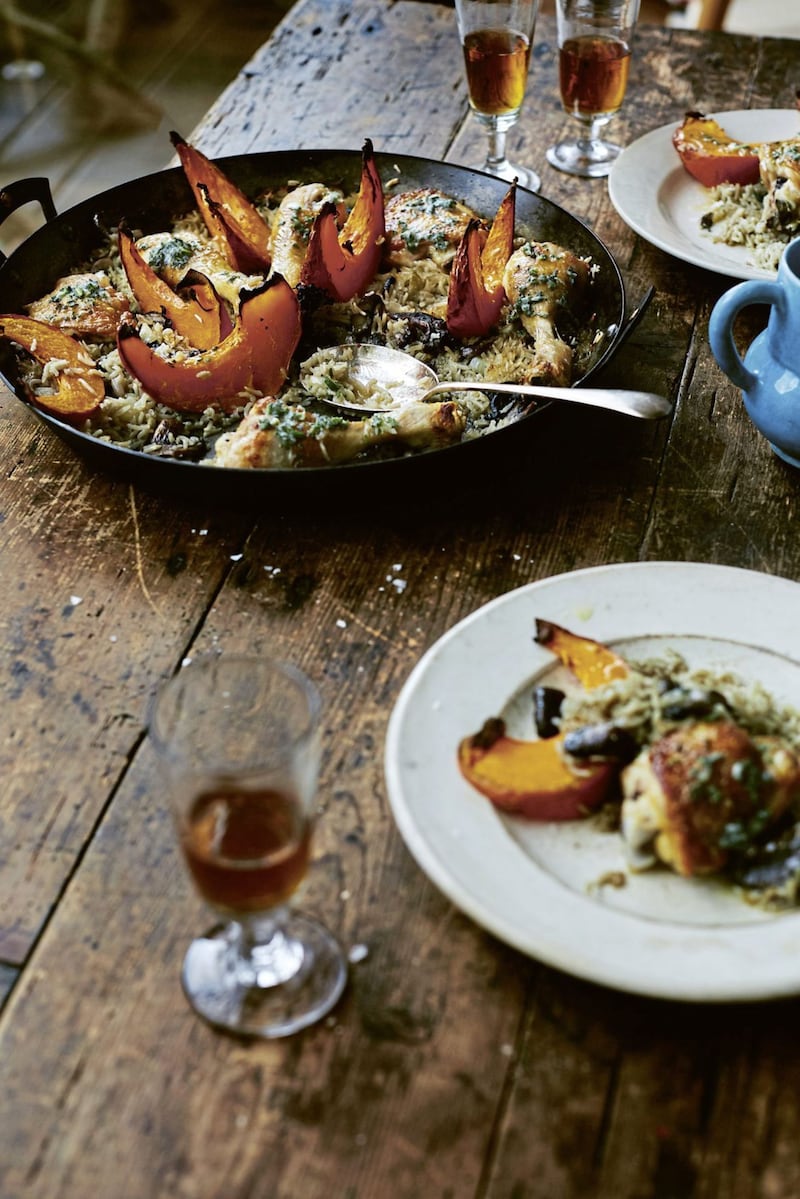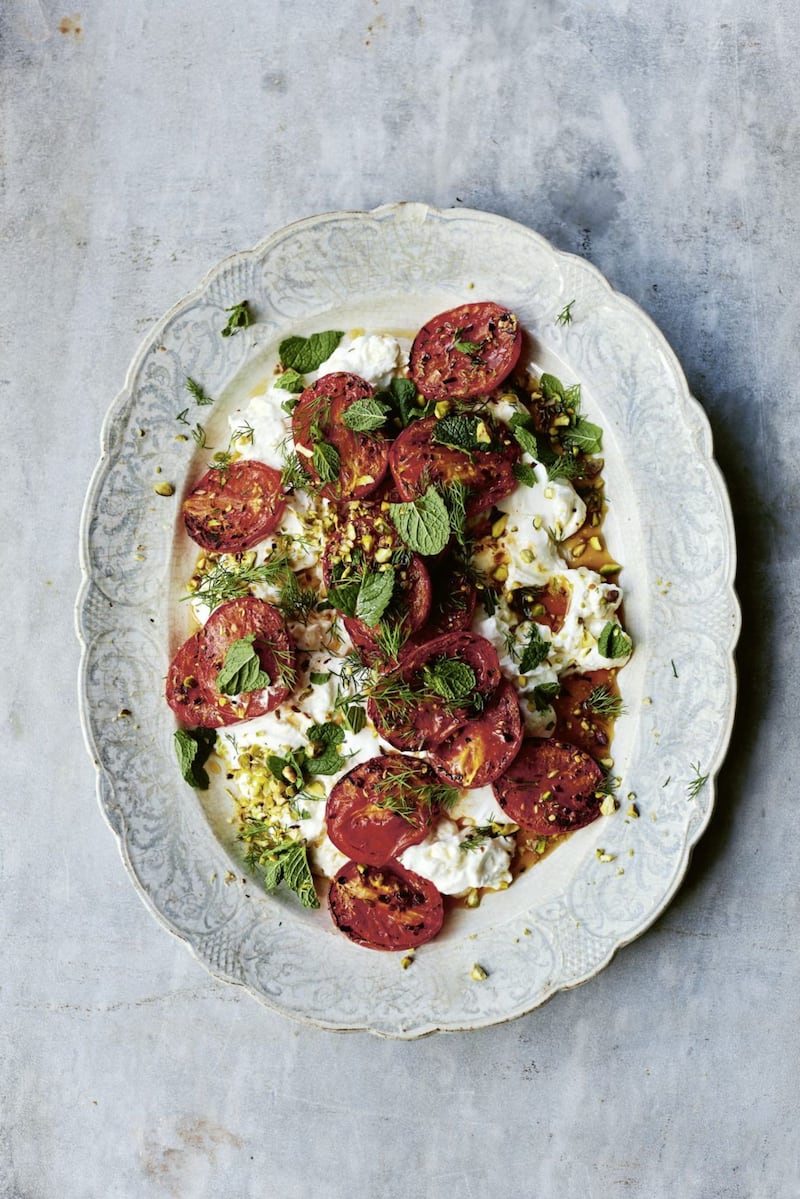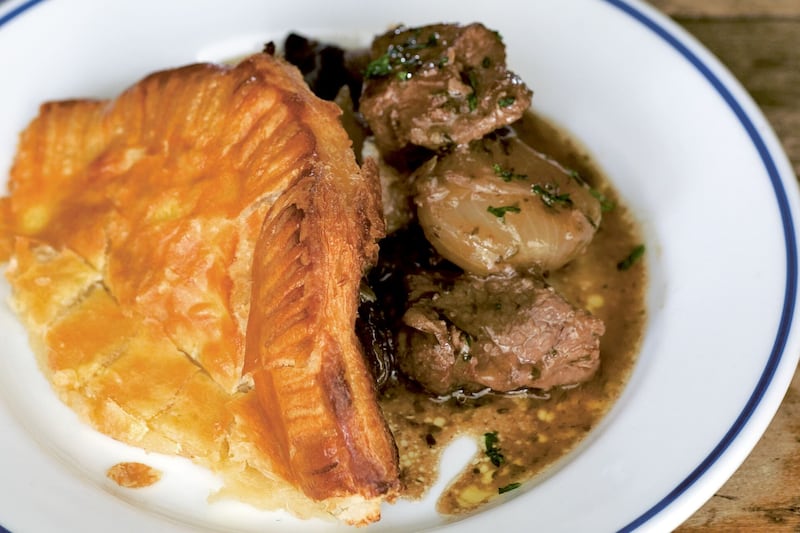ONE of the greatest things about the change in seasons – that bright heat of summer shifting into the golden warmth of autumn – is the fact you can use your oven again without feeling bad about it. But what to put in it?
For this, food columnist and cookbook author Diana Henry (55), has concocted her latest recipe collection, From The Oven To The Table.
It is part of a culinary lineage of Co Down-born Henry's, which started when she had children. The former TV producer, who was raised on the north Antrim coast, says she "found it impossible to stand and brown meat for casseroles or stir risottos", and needed new methods for making dinner.
"My first child cried constantly, so I had to find a way of cooking with one hand while I carried him round on my hip," she remembers. "That meant bunging things in the oven."
She began amassing recipes focused purely on ingredients that could be roasted or baked, eventually slipping them helpfully into her cookbooks (Cook Simple, and later just Simple) – and now she's dedicated an entire tome to them.
"I pretty much cook like this from Monday to Thursday," she says. "I do more demanding dishes at the weekend when I have more time, but the rest of the week, I am very much a 'bung it in the oven' cook."
Between the ease and minimal washing up (the joy!), Henry says there is "something particularly seductive about oven dishes".
As she points out: "The cook doesn't have to do much, except shop well and have a few ideas for dishes. The food usually looks pretty unpromising when you put it in the oven, but then you pull out a golden, burnished dish 45 minutes later."
It's magic. Delicious, straightforward magic. It makes you look good too – because if your friends aren't impressed by a huge dish of something lustrous and roasted, plonked on the table in front of them, get new friends.
Your oven might be a gnarled, molten-cheese-encrusted contraption, but, Henry argues, it has quite extraordinary, transformative properties.
"It isn't just a simple technique, or a lazy one," she says of roasting. "I love what it does to food – it scorches the edges of pumpkin wedges and intensifies their flavour; it makes the skin of chicken golden and crispy. And you don't have to do anything while that happens."
She notes it also improves ingredients too, like "insipid tomatoes, woolly apricots – simply by driving off moisture and finding the sweetness that's in there".
Perhaps even more than the food, Henry is a true defender of the table on which it sits. Wooden, glass, huge, or dinky enough to just wedge a couple of chairs under, it is, she says, "where we come together".
"If we can't cook easy dishes, we use that table less often," she muses. "I know that if my kids and I – because of after-school sports, or because I am away for work – don't eat together, something goes a bit awry.
"The table is where we chat and exchange news and views. It's where we actually look at each other. You need dishes that are easy if you are going to eat around the table as often as possible."
She finds putting chicken thighs on the table really works. In fact, the woman is a chicken fiend – historically her books have been largely devoted to the queen of poultry, and From The Oven To The Table is no different – there's a whole chapter on them.
Henry pairs them with everything from plums, honey and pomegranate, to lemon, capers and thyme, and cauliflower, potatoes and n'juda ("That dish has so much punch. All you need with it is a green salad").
"I cook chicken thighs so much," she admits, putting their appeal down to convenience and the fact her two sons love them.
Her advice to parents of teens, who are prone to surviving on noodles and cheese on toast, is: "Leave them to fend themselves for a while. If you've brought them up eating good food, that's what they'll want to make – eventually."
When she's not cooking, or writing her Telegraph recipe column, Henry is often travelling, picking up ideas and immersing herself in cookbooks.
"I very strongly feel that a cookbook has to be much more than just a collection of recipes," she adds. "Too many cookbooks don't have an approach, or a 'take', or a strong voice." That's not something she need worry about with this one.
:: From The Oven To The Table: Simple Dishes That Look After Themselves by Diana Henry, photography by Laura Edwards, is published by Mitchell Beazley, priced £25 (octopusbooks.co.uk). Below are three recipes from the book for you to try.

CHICKEN WITH WILD MUSHROOMS, PUMPKIN, RICE AND SAGE BUTTER
(Serves 4)
For the chicken and rice:
15g dried wild mushrooms
500ml chicken stock
170g basmati rice
1 onion, roughly chopped
125g chestnut mushrooms, trimmed and thickly sliced
8 good-sized skin-on bone-in chicken thighs, excess skin neatly trimmed
345g pumpkin or butternut squash, deseeded and chopped into big chunks or wedges (prepared weight)
A little extra virgin olive oil
Sea salt flakes and freshly ground black pepper
For the sage butter:
75g unsalted butter, at room temperature
6 sage leaves, finely chopped
1 small garlic clove, finely grated
Method:
Preheat the oven to 190C fan (400F), Gas Mark 6. Soak the wild mushrooms in 75ml just-boiled water for 15 minutes.
To make the sage butter, mash the butter with the sage and garlic and set it aside. Drain the wild mushrooms, adding their soaking liquid to the chicken stock. Wash the rice in a sieve under the cold tap, until the water runs clear, to remove the excess starch.
Put the onion and both the chestnut and dried mushrooms into a 30cm saute pan or shallow casserole (the width is very important) and sprinkle on the rice (it may not look like much, but it expands, don't worry). Put the chicken thighs, skin side up, and the pumpkin on top. Sprinkle a little olive oil over the vegetables and chicken and season well. Bring the stock mixture to the boil, then carefully pour it around the chicken thighs.
Bake in the oven for 45 minutes, by which time the chicken will be lovely and golden and the stock will have been absorbed. Put knobs of the sage butter over the chicken thighs, allow it to melt, then serve.

CHILLI-ROAST TOMATOES WITH FETA CHEESE
(Serves 4)
750g plum tomatoes, halved lengthways
4tbsp extra virgin olive oil
3tsp chilli flakes
2tsp fennel seeds
Sea salt flakes and freshly ground black pepper
4tsp runny honey
225g Greek yogurt, or more, depending on the size of your serving plate
150g feta cheese, crumbled
1 garlic clove, finely grated
5g dill, chopped, any coarse stalks removed
10g mint leaves
10g shelled unsalted pistachio nuts, chopped
Method:
Preheat the oven to 190C fan (400F), Gas Mark 6. Put all the tomatoes into a roasting tin in which they can lie in a single layer; if they are too close to each other, they will just steam instead of roasting. Spoon three tablespoons of the oil over them, then turn them over with your hands so they get well coated. Leave them cut sides up.
Put the chilli flakes and fennel seeds into a mortar and bash them. You won't break the fennel seeds down, but you'll crush them a bit. Sprinkle these over the tomatoes and season. Mix the honey with the remaining olive oil and spoon a little over each tomato.
Cook for 30 minutes, but keep an eye on them: You may find they need a little longer, but don't overcook them. They get to a point when they completely collapse and – even though they're delicious at this stage – they've lost all their shape and you don't want that here.
Stir the yogurt, feta and garlic together and season. Put the yogurt on a serving plate and pile the roast tomatoes on top. Sprinkle the herbs and pistachios all over the dish and serve.
SOUR CHERRY, ROSE AND CARDAMOM BRIOCHE PUDDING
(Serves 8)
125g dried sour cherries
About 100ml unsweetened pomegranate juice
300ml double cream
300ml whole milk
Pinch of sea salt
Seeds from 2 cardamom pods, ground
3 large eggs, plus 1 large egg yolk
150g caster sugar
250g brioche loaf
35g unsalted butter, softened
1tsp rose water, or to taste
Squeeze of lemon or lime juice
Icing sugar, to dust
Method:
Put the dried cherries in a small saucepan and add enough pomegranate juice to just cover. Bring to the boil, then take off the heat and leave the cherries to sit and plump up (they need at least 30 minutes, but longer is fine).
Bring the cream, milk and salt to the boil in a heavy-based saucepan with the cardamom, then leave for 15 minutes off the heat. Beat the eggs, egg yolk and sugar together. Pour the warm milk mixture on to this, stirring constantly.
Slice the brioche, butter it and layer it in a two-litre (3.5 pint) ovenproof dish, scattering the soaked cherries and any leftover pomegranate juice on as you layer the bread (try to get most of the cherries under the bread, or they might burn). Add some rose water to the egg and cream mixture – not too much – and a squeeze of lemon or lime juice, then taste it. You should be able to detect the rose water, but it shouldn't be too strong. Brands differ in strength, so you have to taste and decide if you need a little more.
Pour the egg and milk mixture evenly over the layers of bread. Leave the pudding to sit for 30 minutes; this will make it lighter. Preheat the oven to 180C fan (375F), Gas Mark 5.
Put the dish into a roasting tin and carefully pour enough boiling water into the tin to come about one-third of the way up the sides of the dish. Bake for 40-45 minutes, or until puffy, golden and just set on the top. Leave to cool slightly – the pudding will continue to cook in the residual heat for a while – then dust with icing sugar before serving.








